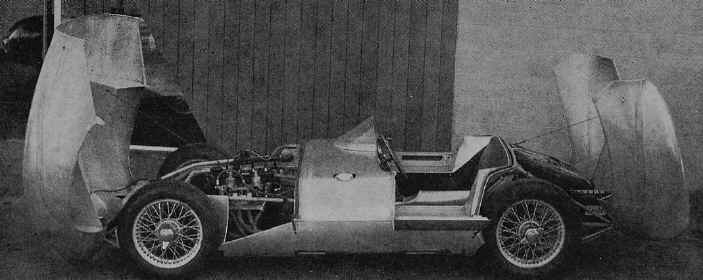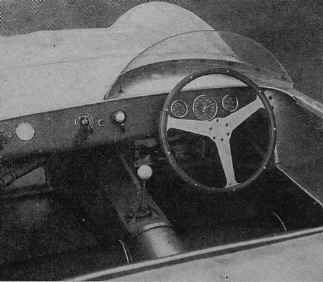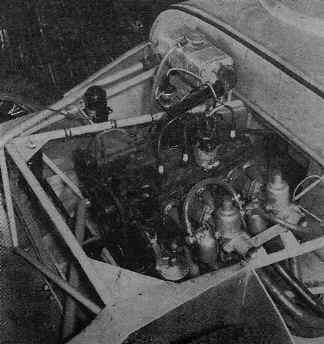
Road & Track, September 1957 |
|
 |
|
Road Test LOTUS SPORTS |
|
|
Expanse of sheet metal in front of passenger will make the Lotus very popular in drive-in restaurants.
I'm a stranger here myself: the little Ford engine looks vaguely uncomfortable in this environment.
an impractical, highly desirable combination
|
IN MARCH of this year we tested
a full competition Lotus, powered
by the famous Coventry-Climax engine and selling for
nearly $6000. In that report we mentioned that a simpler and
cheaper version, known as the "Sports" model, was also manufactured
by Lotus. The report ended with "Even the lowest-priced
model may not put a Lotus in every garage, but it
would certainly make an interesting racing class if enough cars
of this type are brought over." This, then,
is a report on the lowest-priced model, powered by
an ordinary Ford "10" side-valve engine and supplied by
the U.S.A. Lotus distributor. Jay
Chamberlain, 2909 West Olive,
Burbank, Calif. The Lotus
Sports ("Club Sports" is not correct) is very similar
to the famous "11" model except for the British Ford engine,
three-speed transmission, solid rear axle and drum brakes.
The multi-tube frame and low-pivot i. f. s. are used, and
the body panels appear to be of identical contour. The racing
windscreen is a simpler type, not at all unpleasing, and
the rather elaborate cockpit cover and head rest of the 11
are dispensed with. A very neat full-width windshield and
a not-too-bad top can be ordered (see photo in R&T for February
1957, page 26).
Parallel
trailing arms support the solid rear axle, with coil springs
here as well as in front. The brake system has twin master
cylinders, two leading shoes, and drums nine and eight
inches in diameter, front and rear. The transmission uses
special close-ratio gears, giving 1.33 for second and 2.34 for
first. While most Lotus (or is it Lotii?) come equipped with 4.50
section tires in front and 5.00 at the rear, our test car had 4.50-15
tires all around. The seating
position feels just right. In the cockpit area, there
is a good feeling of neat, functional aluminum—comfortable, but hardly
luxurious. All the controls work smoothly and easily, and the shift
pattern is standard. In starting off,
the high first gear (9.87:1 overall) is noticeable for the first
few feet, and for an instant one wonders whether this might
not be second gear. But from 5 mph upwards, the surge of
power is very good indeed; the Tapley meter swings over to
510 lb/ton and 30 mph comes up in under 5 seconds, even after
the initial hesitation. Slightly over 40 mph is possible in
first gear (40 mph=5500 rpm), and the engine seems happy at
this rate, though low gear is somewhat noisy and of course not
synchronized. Second gear is relatively quiet, and gives a good
boost with a peak Tapley reading equivalent to accelerating at the rate
of 3. 1 mph/sec. Actually, 40 to 70 mph in second gear requires 11.9 seconds, whereas 3.1 mph/sec. would
give an elapsed time of 9.68 seconds, but the Tapley reading
falls off rather rapidly above 40 mph (3100 rpm). This
is, of course, due to the fall-off in engine torque and the increase
in wind drag, as the speed continues to increase. Speaking of
drag figures, this car showed—after numerous tests
in both directions—a total wind and rolling resistance of
only 55 lb at 60 mph, as compared to 68 lb for our Lotus 11
test. From this we can calculate that the Sports model, with racing
screen and two persons up, can hold 60 mph with only 9
bhp required at the flywheel. We made only
two timed high-speed runs; the second was
the faster, at 99.0 mph. Perhaps a third run would have found
the engine just enough freer that the magic three-figure mark
could have been attained, but the engine temperature would
start to climb under this treatment, and we were reluctant to risk a piston seizure. Incidentally, the speedometer was
dead accurate at 99 mph and the engine was held wide open
for over two miles on each run, reaching a calculated 5700
rpm at the end. (No tachometer is supplied, which seems
deplorable in a sports machine of this price.) Our test
driver was Ignacio Lozano, well known for his support of the marque
Lotus. Getting the most and the best out of this car presents no special problems—it is very easy to drive,
with one exception: Up to 70 mph or so the steering feels
wonderful. With 1.5 turns and a 42-foot turning circle, the
overall steering ratio isn't terribly quick. Nevertheless, at 90
mph the car suddenly seems to get as nervous as a wild horse,
and frankly it was rather frightening. Experienced Lotus
drivers say you get used to this, but for most tastes a slower
gear and a smaller turning circle would be preferable. The ride is
quite firm, and on this car at least, the lack of a
de Dion rear end is not felt at all. As might be expected from
the weight distribution, the car understeers, but the raised
roll center in front reduces the understeer to a very modest
amount. Insofar as roll is concerned, there is (under normal
driving conditions) no such thing. Only when the tires
begin to squeak, signifying the approach of one g lateral forces,
does the car lean at all perceptibly. In order to
show the range of performance which can be expected
from a modified Lotus Sports, we have plotted the results
of a British test in dotted lines against our usual acceleration graph.
However, the overseas car carried a test weight approximately 200 lb below our figure, and the engine had quite
a few internal modifications, including higher compression ratio,
polished ports and oversize valves. Both test cars had
twin S.U. carburetors. Accordingly, we have estimated that our car had about 40 bhp as compared to 45 or so for the more
modified machine. In short,
and with only one or two minor complaints, we liked
the Lotus Sports very much indeed. But now we must register
what may sound very much like a sermon —and it is.
Here is a car for which we can discover no useful purpose whatsoever! In two
years, Lotus has built up a very good reputation in this
country and sold nearly 100 machines. The cars are beautifully
engineered, tremendous competition cars in their class,
and cost near $5000. Now, in the new Ford-powered Sports,
we have an equally fine machine. And, as we quoted earlier,
it would make an interesting racing class. But as it stands
now, this car is far too expensive ever to get a Ford 1172
class going. It would compete with
its 1460 cc Coventry-Climax-powered cars,
a daring but hopeless enterprise. So, we add
the windshield, top and side curtains, securing thereby a very fine and unique
dual-purpose car? Almost, but wait. In
the first place, the price is $1500 more than
the Ford-10-powered Morgan 4/4, although the Lotus weighs 580 lb less.
But, more importantly, the
Lotus has so little ground
clearance that anything larger than a
pebble in the street will rake the belly pan from
stem to stern. Enclosed front wheels would
make parking a matter of finding a space
vacated by an Imperial, and what American
bumpers would do to that beautiful but unprotected aluminum would be sheer slaughter.
Coil springs having at least one inch
more loaded height and 5.00 tires would increase
the ground clearance to a sensible minimum of 6.5 in. The front fenders could be
cut away to give a turning circle of 30 to
32 ft, but that isn't easy. We would be
so bold as to suggest a redesigned 1172 cc car, and possibly a larger
all-out competition machine offered for sale at about the same price, without an engine or gearbox.
And what would we damn Yanks install
for power? An American V-8! |
|
Web editor’s note: Many Eleven Sports were built but the test car, chassis #234, was the only one officially imported to the USA by Chamberlain. Over the years most Sports models were converted to use other engines and very few – if any – original Ford 1172 Elevens exist today. |
|
| BACK to Design & Production | |
| HOME to www.lotuseleven.org | |


